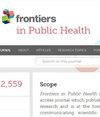2016-2020 年中国湖南省出生缺陷总患病率、围产期患病率和活产患病率比较
IF 3
3区 医学
Q2 PUBLIC, ENVIRONMENTAL & OCCUPATIONAL HEALTH
引用次数: 0
摘要
目的 任何类型的出生缺陷都是不可取的,往往会对新生儿的健康和发育造成负面影响。利用卫生相关监测项目的数据集进行出生缺陷监测,有助于预测出生缺陷的模式并采取预防措施。本研究比较了出生缺陷的总患病率、围产期患病率和活产患病率。方法数据来源于中国湖南省出生缺陷监测系统(2016-2020 年)。总患病率是指每千名新生儿(包括活产和死产)中出生缺陷(包括活产、死产和选择性终止妊娠)的数量。围产期患病率是指每 1,000 名新生儿中(妊娠 28 周至产后 7 天)出生缺陷的数量。活产率是指每千名新生儿中活产出生缺陷的数量(单位:‰)。低估比例(单位:%)是指围产期患病率或活产患病率与总患病率相比的下降水平。流行率及 95% 置信区间 (CI) 采用对数二项式法计算。结果 本研究共纳入 847 755 例新生儿,共发现 23 420 例出生缺陷,其中胎龄 > =28 周的出生缺陷 14 459 例(61.74%),活产出生缺陷 11 465 例(48.95%)。出生缺陷的总患病率、围产期患病率和活产患病率分别为 27.63‰(95%CI,27.27-27.98)、17.06‰(95%CI,16.78-17.33)和 13.52‰(95%CI,13.28-13.77),它们之间存在显著差异(χ2 = 4798.55,p &;lt;0.01)。与总患病率相比,围产期患病率和活产患病率分别低估了 38.26% 和 51.05%。根据年份、性别、居住地和产妇年龄的不同,所有分组的出生缺陷总患病率、围产期患病率和活产患病率之间存在显著差异(p &;lt;0.05)。17 种特定缺陷的总患病率、围产期患病率和活产患病率之间存在显著差异:先天性心脏缺陷、唇腭裂、唐氏综合征、马蹄内翻足、脑积水、肢体萎缩、唇裂、脐膨出、肛门闭锁、无脑畸形、脊柱裂、膈疝、无脑儿、胃畸形、食道闭锁、膀胱萎缩和连体婴儿(p&;lt; 0.05).相比之下,多指畸形、其他外耳缺损、联合畸形、尿道下裂、腭裂和无肛/小耳畸形这 6 种特定缺陷的总患病率、围产期患病率和活产患病率之间没有明显差异(p&;gt; 0.05)。本研究对出生缺陷的总患病率、围产期患病率和活产患病率进行了系统的比较。研究发现,出生缺陷(包括多种特殊缺陷)的总患病率、围产期患病率和活产患病率之间存在显著差异,年份、性别、居住地和孕产妇年龄对其有显著影响。研究结果将有助于采取预防出生缺陷的措施,也有利于公共卫生人员和政策制定者改善目前的状况。本文章由计算机程序翻译,如有差异,请以英文原文为准。
Comparison of total prevalence, perinatal prevalence, and livebirth prevalence of birth defects in Hunan Province, China, 2016–2020
ObjectiveBirth defect of any type is undesirable and often pose a negative impact on the health and development of the newborn. Birth defects surveillance with datasets from surveillance health-related programs are useful to predict the pattern of birth defects and take preventive measures. In this study, the total prevalence, perinatal prevalence, and livebirth prevalence of birth defects were compared.MethodsData were obtained from the Birth Defects Surveillance System in Hunan Province, China, 2016–2020. The total prevalence is the number of birth defects (including livebirths, stillbirths, and selective terminations of pregnancy) per 1,000 births (including livebirths and stillbirths). The perinatal prevalence is the number of birth defects (between 28 weeks gestation and 7 days postpartum) per 1,000 births. The livebirth prevalence is the number of liveborn birth defects per 1,000 births (unit: ‰). Underestimated proportion (unit: %) is the reduction level of perinatal prevalence or livebirth prevalence compared to the total prevalence. Prevalence with 95% confidence intervals (CI) was calculated using the log-binomial method. Chi-square tests (χ 2 ) were used to examine if significant differences existed in prevalence or underestimated proportion between different groups.ResultsA total of 847,755 births were included in this study, and 23,420 birth defects were identified, including 14,459 (61.74%) birth defects with gestational age > =28 weeks, and 11,465 (48.95%) birth defects in livebirths. The total prevalence, perinatal prevalence, and livebirth prevalence of birth defects were 27.63‰ (95%CI, 27.27–27.98), 17.06‰ (95%CI, 16.78–17.33), and 13.52‰ (95%CI, 13.28–13.77), respectively, and significant differences existed between them (χ2 = 4798.55, p < 0.01). Compared to the total prevalence, the perinatal prevalence and livebirth prevalence were underestimated by 38.26 and 51.05%, respectively. Significant differences existed between the total prevalence, perinatal prevalence, and livebirth prevalence of birth defects in all subgroups according to year, sex, residence, and maternal age (p < 0.05). Significant differences existed between the total prevalence, perinatal prevalence, and livebirth prevalence for 17 specific defects: congenital heart defect, cleft lip-palate, Down syndrome, talipes equinovarus, hydrocephalus, limb reduction, cleft lip, omphalocele, anal atresia, anencephaly, spina bifida, diaphragmatic hernia, encephalocele, gastroschisis, esophageal atresia, bladder exstrophy, and conjoined twins (p < 0.05). In comparison, no significant difference existed between the total prevalence, perinatal prevalence, and livebirth prevalence for 6 specific defects: polydactyly, other external ear defects, syndactyly, hypospadias, cleft palate, and anotia/microtia (p > 0.05).ConclusionThe total prevalence and livebirth prevalence of birth defects in Hunan Province, China, was not well studied. A systematic study was conducted to compare the total prevalence, perinatal prevalence, and livebirth prevalence of birth defects. The study reveals that significant differences existed between the total prevalence, perinatal prevalence, and livebirth prevalence of birth defects (including many specific defects), and year, sex, residence, and maternal age had significant impacts on it. The outcomes of the study will help to take preventive measures for birth defects as well as benefit the people involving public health and policymakers to improve the current scenario.
求助全文
通过发布文献求助,成功后即可免费获取论文全文。
去求助
来源期刊

Frontiers in Public Health
Medicine-Public Health, Environmental and Occupational Health
CiteScore
4.80
自引率
7.70%
发文量
4469
审稿时长
14 weeks
期刊介绍:
Frontiers in Public Health is a multidisciplinary open-access journal which publishes rigorously peer-reviewed research and is at the forefront of disseminating and communicating scientific knowledge and impactful discoveries to researchers, academics, clinicians, policy makers and the public worldwide. The journal aims at overcoming current fragmentation in research and publication, promoting consistency in pursuing relevant scientific themes, and supporting finding dissemination and translation into practice.
Frontiers in Public Health is organized into Specialty Sections that cover different areas of research in the field. Please refer to the author guidelines for details on article types and the submission process.
 求助内容:
求助内容: 应助结果提醒方式:
应助结果提醒方式:


